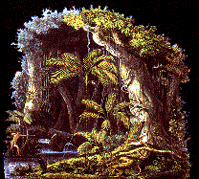

???? The Amerindians migrate to, and inhabit South America. The legend of the Empire Of Eldorado is born.
1593 -The earliest account of the territory of Guiana is made in a dispatch to the Royal Council of Spain in which the Governor of Trinidad, Antonio de Berreo, describes his journey down the Oronoco and his attempt to explore Guiana.
1594 -Sir Robert Dudley makes inquiries about the rumoured Empire of El Dorado when his ship puts in to Trinidad. A small boat is sent to investigate and its crew returns to say that the natives (Amerindians)had told them of gold-mines so rich that the people of the country powdered themselves with gold dust. 'And farre beyond them', they said, 'a great towne called El Dorado, with many other things.'
1598 -The Dutch make their first voyage to Guiana.
1621 - Dutch West India Company receives a charter for the Essequibo.
1640 - Slaves arrive in the colonies from Africa.
1657 -A small Dutch settlement is established on the Pomeroon River.
1666 - War breaks out between England and Holland.
1763 -The Berbice Slave Rebellion breaks out (at the time when Berbice is a separate Dutch colony). It begins on one estate, but soon spreads to others along the Berbice River. The revolt is the result of the cruelty with which the Dutch plantation owners have been treating their slaves, and it is led by a male slave called Coffy. The few hundred white settlers are soon overwhelmed, and the uprising will only be put down after the arrival of warships and with the help of troops from as far away as Barbados.
[Coffy will commit suicide three months after the beginning of the affair . His followers will be hunted down for another year, before the Dutch authorities will be satisfied that the rebellion has been crushed.]
1781 -War breaks out between England and Holland. The colonies of Demerara, Essequibo, and Berbice are taken by the English.
1782 - Some months later, the French, who are also at war with England (and who are the allies of Holland), under the command of the Marquis de Lusignan (whose name is perpetuated in the plantation of that name) take the three colonies. The French build Fort Dauphin at the mouth of the Demerara, and nearby, begin to build a new town - "Longchamps".
1783/4 - (a) The colonies are restored to Holland. (b)Longchamps is chosen as the site of the new colonial capital, later to be called Stabroek. (c) The Dutch move the seat of Government for the Demerara territory down river to its mouth, where they begin to build the town of Stabroek in a geometrical 'grid-iron' system of streets, divided by canals in the manner of their home-country. (d) The Dutch build a series of sluice-gates or kokers at points where the canals meet the Demerara estuary. At high tide, the kokers form a barrier between the Atlantic Ocean and the canals. At low tide they are opened to allow the accumulated water from the land to flow away.
1796 -War breaks out again between England and Holland. The colonies are taken by England, for the second time.
1802 -At the peace of Amiens, Guiana is returned to the Dutch. English settlers are given three years to wind up their affairs, and to then leave.
1803 - War breaks out again between England and Holland. In September, Hood arrives at the mouth of the Demerara, and demands the surrender of the Colony. Guiana is handed over without fighting, never again to be returned to Holland.
1811 - The first St. George's (Church) is constructed in George Town (on the site where St. George's school now stands).
1812 - The town of Stabroek is renamed 'Georgetown'.
1814 - Demerara, Essequibo and Berbice are assigned to England during the Great peace.
1822 - The Town of New Amsterdam is laid out in Berbice.
1823 - There is a slave insurrection on the East Coast of Demerara.
1828 - The Public Buildings (now Parliament Buildings) are built - Hadfield, architect. (completed 1834)
1830 - The 103ft tall, red and white striped Lighthouse is erected at the mouth of the Demerara River (Water Street). It replaces the original wooden structure that was built in 1817 by the Dutch.
1833 -The Act Of Abolition of slavery is passed. The slaves are not granted full freedom, but are bound to their masters for three-quarters of each day for a period of seven years.
1835 - Portuguese labourers are imported for work on the plantations. (Almost one thousand immigrant Portuguese die from tropical diseases).
1837 - John Gladstone suggests East Indian indentured labour as a solution to the drifting of Africans from the plantations to the towns. Permission is granted to bring 'Coolies' for his two plantations.
1837 - While exploring what was then British Guiana, botanist Robert Schomburgk stumbles across a spectacular water lily of gigantic proportions. Stretching about six feet across, the lily-pad looks like an enormous pie plate and can easily support a coiled boa napping in the shade of its tremendous blossom, which boasts an expansive corolla that runs the gamut of pink between its pearly white petals, and bright red center. The chivalrous Schomburgk christens the future pride of botanical gardens "the Victoria Regia" in honour of the British sovereign.
1837 - Georgetown has its first Mayor and Town Council.
1838 - A floating light is placed on the Demerara 'Bar'.
1838 - August 1st,"Full and unqualified liberation of the Negroes".
1838 - The first indentured labourers drawn from the hill areas of South India, arrive in Guiana. 156 East Indians arrive from Calcutta on the "Hesperus". They are under indenture for a five year period, and for the first part, they are housed and given rations, but are not paid. Great mistreatment of the labourers result in prosecution of some of the planters.
1838 - Schomburg discovers Mount Roraima.
1838 - The Colony is divided by ordinance into the three counties of Demerara, essequibo, and Berbice.
1839 - Four hundred German Rinelanders and Wurtembergers are enticed to British Guiana. (Almost all succumb to tropical diseases).
1842 -Georgetown is declared a city.
1842 - In June, a new and larger St. George's (church) is opened (on the present site) in Georgetown. This building will later become the first St. George's Cathedral.
1843 - The corner stone for the Public Buildings (now the Parliament Buildings) is laid in Georgetown.
1843 - The end of the first period of indenture. Many of the labourers return to India.
The 1840's - England suspends the indentured labourer system. Immigrant labour from India, Portugal (mainly Madeira) and China is permitted, under Government control.
1844 - Queen's College is founded.
1848 - The Demerara Railway Company introduces the railway in British Guiana. The railway runs from Georgetown for 60 miles down the Atlantic coast, to Rosignol on the Berbice River.
1853 - January 12th. The first contract Chinese labourers arrive in British Guiana on the "Glentanner". Most are assigned to Windsor Forest, Pouderoyen and La Jelousie estates.
1856 - February 18th,Georgetown riots - property of Portuguese destroyed.
1860 - March 11th. The first female Chinese labourers arrive on the "Whirlwind".
1864 - The Mahaica Bridge is opened.
1870 -Members of a geological survey team discover the Kaieteur Fall on the Potaro River in central Guyana.
1874 - The last contract Chinese labourers arrive in Demerara.
1878 - Gold is discovered in Guyana, sparking an economic boom.
1879 - Between 1879 and 1884 the Botanical Gardens are laid out on the site of an abandoned sugar plantation - Vlissengen. Located at the eastern end of the city's limits, the gardens are laid out by a Trinidadian - J. F. Waby, from plans previously prepared by another Trinidadian - botanist H. Prestoe.
1880's -The Stabroek Market is built. This structure is inspired by the Dutch style of building. It is a long gabled building framed in iron with a facade of white and brick-red painted wood, with a central clock tower, capped by a red pyramid supported by slender posts on a balconied roof.
1882 -As a barrier, the 'kokers' are inefficient; the sea and the river are constantly encroaching on Stabroek. In 1882, construction of the Sea Wall is completed, and keeps the water under control.
1884 - The Promenade Garden is extended to its present (21st century)proportions on an entire city block (east of State House.) This area was once used as a public display for the hanging of slaves who were connected with the 1823 East Coast rebellion.
1884 - Sir Everard Im Thurn ascends Mt. Roraima.
1889 - The Town Hall (now the City Hall) is opened in the city of Georgetown.
1890 - Secondary diamond deposits are discovered in Western Guyana. (Since 1890, Guyana has produced 4.5 million carats).
1892 - A new St. George's Cathedral (the fourth St. George's structure) is constructed in the city of Georgetown.
1899 - The International Tribunal establishes the country's borders.
1900 - October 18The jagans, Cheddie's parents, left Calcutta in the "Elbe". Arrived Demerara on January 5th, 1901.
1904 - The demarcation of the boundary between Guyana and Venezuela in accordance with the 1899 Award of the Paris Tribunal, is completed.
In June the King of Italy hands down his award in the arbitration proceedings between Brazil and British Guiana.
1917 - The Government of India abolishes the indentured system. No more East Indian labour is allowed to enter Guiana.
1923 - The old drainage system, which provided an excellent breeding ground for disease and insects, is replaced by a pipe-line sewage system. The introduction of the pipe-line sewage system permits the filling-in of many of the central canals . (The avenue which now runs down Main Street was once a canal filled with the Victoria Regia lily plants.)
1928 - The Constitution is changed, and women are given the vote on the same terms as men.
1946 - Census - population 375,819
1948 - The Enmore Tragedy occurs, with an attack against militant sugarcane workers.
1950 - A piped supply of potable water is made available in Georgetown.
1953 - The Waddington Constitution is suspended on December 22nd. The Royal Welsh Fusiliers are dispatched to British Guiana to control any outbreak of violence which may follow the suspension. The House Of Assembly is disbanded. All political parties are forbidden to hold meetings, and certain P.P.P. leaders are forbidden to leave Georgetown. The Legislative Council is now composed of nominated and ex-officio members.
1954 - On June 6, the British Guiana Credit Corporation commences its operation. This facility's objective is to provide credit for the development of small businesses.
The construction of 18 low cost houses ($1,150.00 each) at east la Penitence Housing Scheme is started.
The Potaro Hydro Electric Company Limited, which proposes to investigate the feasibility of exploring British Guiana's hydro-electric potential, is registered.
1955 - British Guiana Airways is purchased by the Government for Stg.823,000 from Colonel Art Williams.
1957 - Guyanese constitution is restored. The PPP splits along racial lines: the Jagans lead a mostly Indian party and Forbes Burnham establishes the People’s National Congress (PNC), with mostly African Guyanese.
1957 - In June, the Clerical Workers' Union changes its name to The Clerical and Commercial Union.
1958 - The Legislative Council passes a resolution exhorting the British Government to grant Cabinet status to British Guiana, as it had conceded to both Trinidad and Jamaica.
1961 - Elections under Internal Self-Government Constitution. The PPP Party is victorious.
1962 - February 13th - Black Friday - Protests and rioting in georgetown. Vehicles and buildings are set alight in Camp Street, and Water street. Looting of commercial enterprises in Regent Street, Camp street, Water Street. Looters running through the streets of Georgwtown with large appliances, bolts of cloth, everything they can lay their hand on. Tear gas and bullets. More British troops arrive on February 14th.
1962 - Arthur Schlesinger, U.S. Secretary of State visits British Guiana and concludes that Dr. Jagan's heart is with the Communist world, and although all alternatives to Dr. Jagan are terrible, he feels that if Mr. Burnham 'will commit himself to a multi-racial policy' an independent British Guiana under him would cause the U.S. fewer problems than one under Dr. Jagan.
The February Riot Commission sits from June 22 to 28th in Georgetown. Senior Counsel Lionel Luckhoo submits DR. Jagan to a robust examination in which Dr. Jagan admits that he is 'a communist'. The circumstances of this admission seriously affects the U.S. attitude to Dr. Jagan and to British Guiana and paves the way for their promotion of Mr. Burnham to political power in Guyana.
1963 - On June 21, 1963, as U.S. President John Kennedy and a high powered team prepares for a meeting with British Prime Minister Harold McMillan and his team at Birch Grove in the U.K., the State Department instructs its U.K. embassy by telegram to let it be known that McMillan had agreed that H.M.G. no longer has any faith in Dr. Jagan, preferring Mr. Burnham as the more manageable alternative. At the Birch Grove meeting, it is decided to establish a Burnham-D'Aguair Government and grant British Guiana independence.
Five people including a High School student are shot and several people beaten as a new wave of violence hits the city on June 11 and June 12.
Georgetown is declared a 'Proclamation Area' and another ban is put on all public meetings.
The Guyana Rice Marketing Board escapes being demolished when a large quantity of dynamite is discovered under the wharf. Two ships, one belonging to the Russian and the other Cuban, recently berthed, also escape destruction.
1964 - Minister of Home Affairs, Hon. Janet Jagan, resigns her post claiming she had no control over the police. Essentially her resignation is in protest of the police inaction to the violence perpetrated against Indians at Wismar-Christianburg earlier in May.
Violence erupts on an intensified scale soon after the arrival on June 17 of a Cuban tanker M.V. Cuba bringing much needed fuel and gasoline to the colony. The forces opposed to the Government of the day had organized an embargo and as such, vital supplies of necessities were delayed. The Cuban vessel is interpreted as breaking the embargo and the opposition parties let loose the 'Gods of War' in Georgetown and its environs.
The Parliament Building is blockaded by angry protesters who assault Ministers and civil servants who dare to remain on the job.
An incendiary device is thrown into the Hadfield Street home of Permanent Secretary in the Ministry of Works and Hydraulics, 52-year-old Mr. Arthur Abraham, causing his death. Seven of his nine children also die. After the fire, four bodies are found huddled together on the stairway and three on the upper flat.
Prime Minister, Harold McMillan, speaking in the House of Commons, on June 17, recommends that the Commonwealth Prime Ministers' Meeting should consult on the crisis situation in British Guiana. On June 24th Prime Minister DR. Cheddie Jagan concurrs.
1964 - Proportional Representative System. A coalition Government of PNC and UF attains power.
1965 - A three storied building which houses the U.S. Consulate and the JFK Library is bombed on June 24. Miss Shakira Baksh (later to be Mrs. Michael Caine) is injured in the blast.
On November 15th, 1965 New "Bank Of Guyana" notes come into circulation in denominations of $1, $5, $10, and $20.

1966 - May 26th,Independence. The colony of British Guiana becomes independent of British rule, and is known as Guyana.

1966 - On June 23, officials from both Guyana and Suriname begin talks in London in relation to the countries' border dispute.
1966 - British troops leave Guyana.
1969 - The protocol of Port-of-Spain is signed by Guyana and Venezuela leading to a 12-year moratorium on the boundary controversy.
1970 - February 23rd,Guyana, the independent country - becomes a Co-operative Republic, and is now known as the "Republic Of Guyana".
1978 - Nine hundred members of a religious sect led by Jim Jones commit mass suicide in Jonestown.
1980 - Massive failure in the Georgetown Electricity Corporation's service to Georgetown. Blackouts become the norm for residents.
1985 - Desmond Hoyte of the PNC becomes president after Burnham dies. The economy begins to deteriorate.
1992 - Cheddi Jagan becomes president in the country’s first free elections since 1966.
1997 - Janet Jagan becomes president after Cheddi’s death
1998 - State of emergency declared after riots occur against the PPP.
1999 - Janet Jagan resigns from Presidency for health reasons and is replaced by Bharrat Jagdeo
For more history, read some of the books listed in "books 2" [ Guyana Scrapbook]